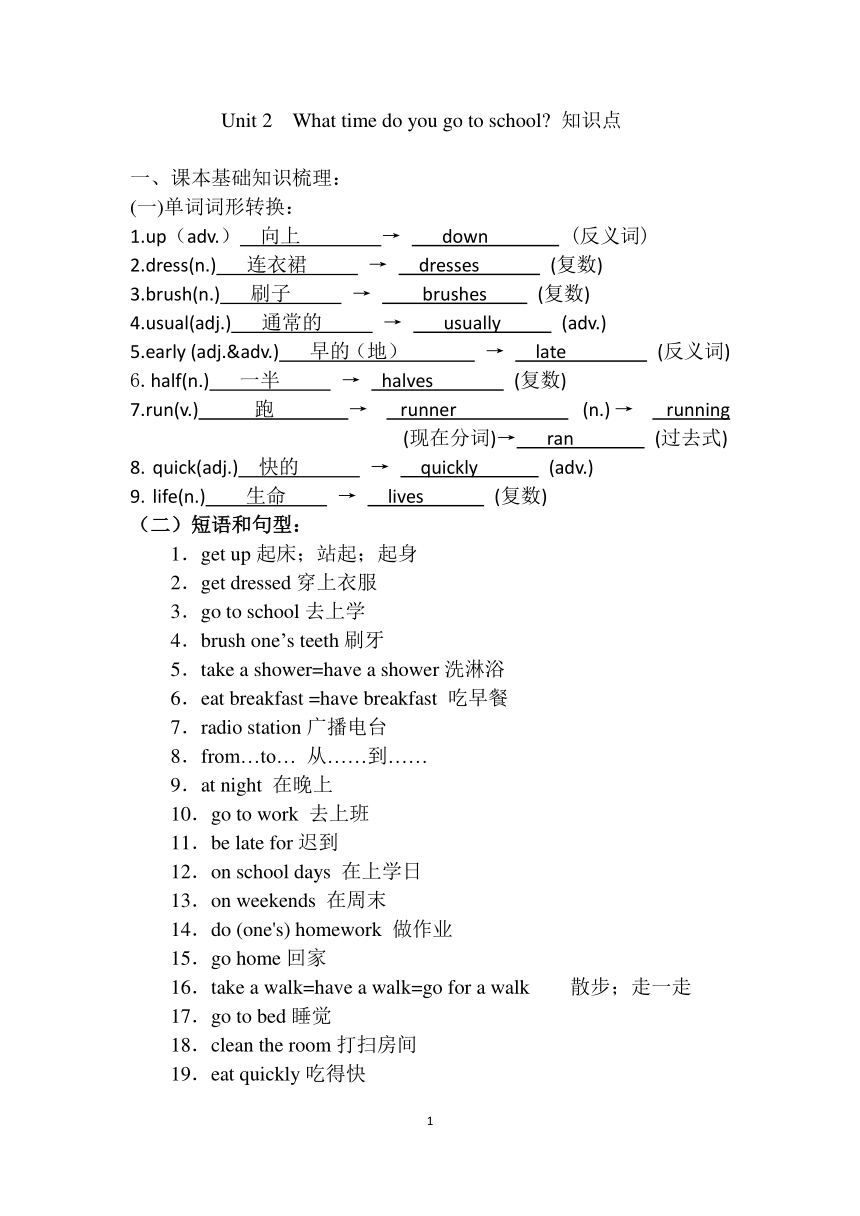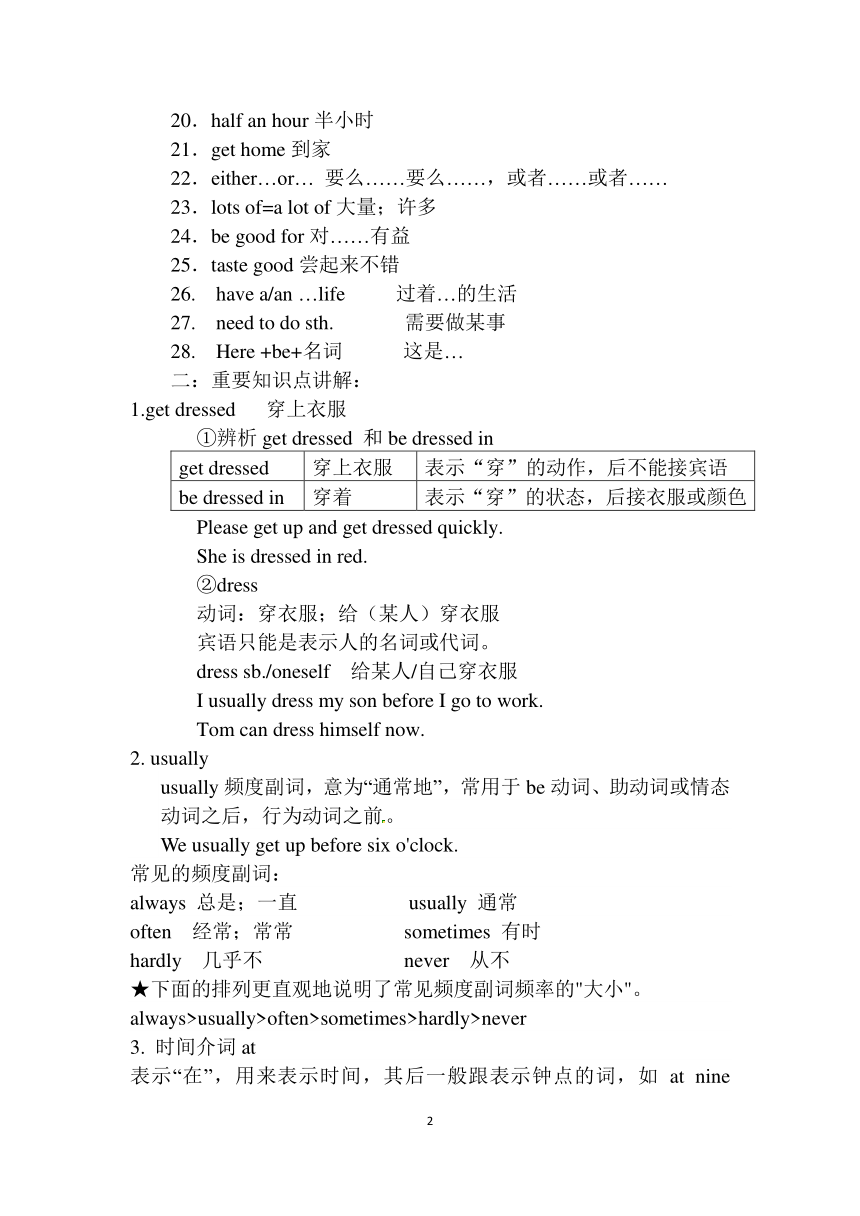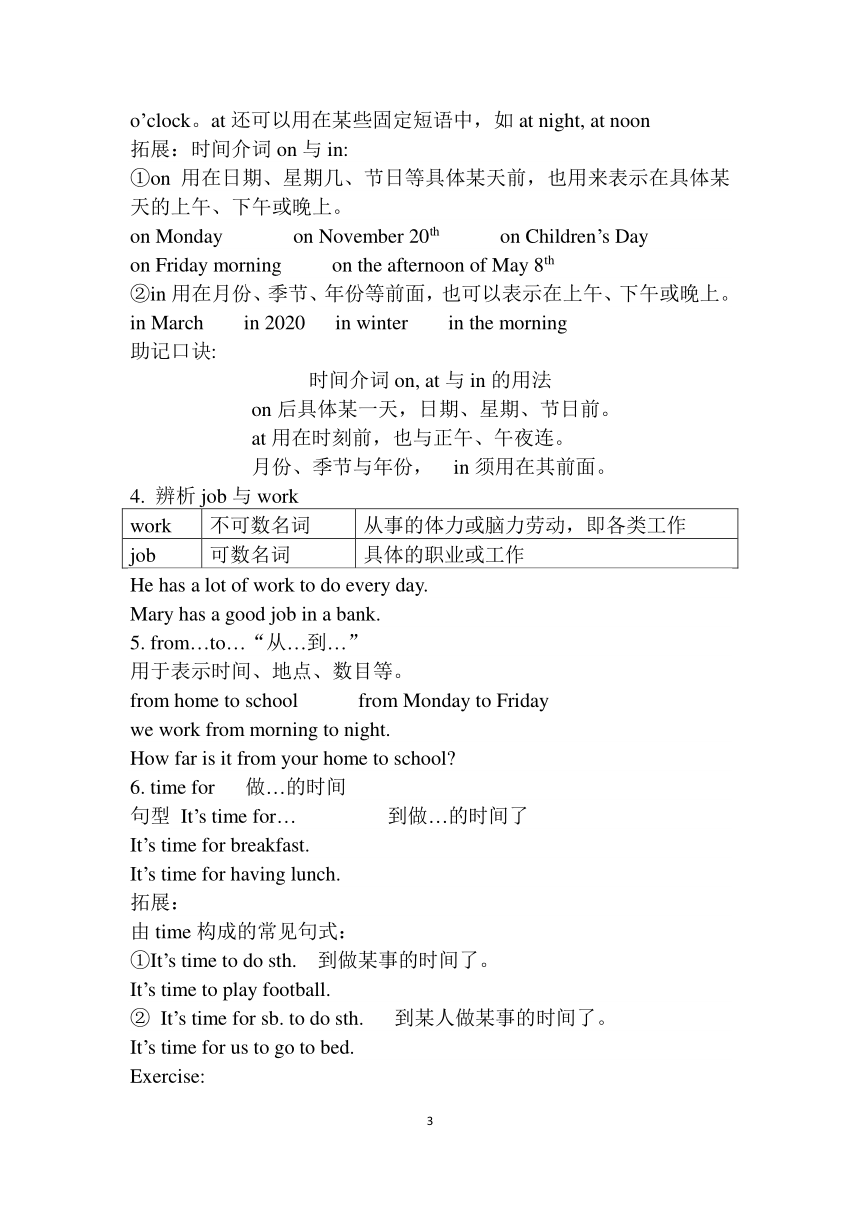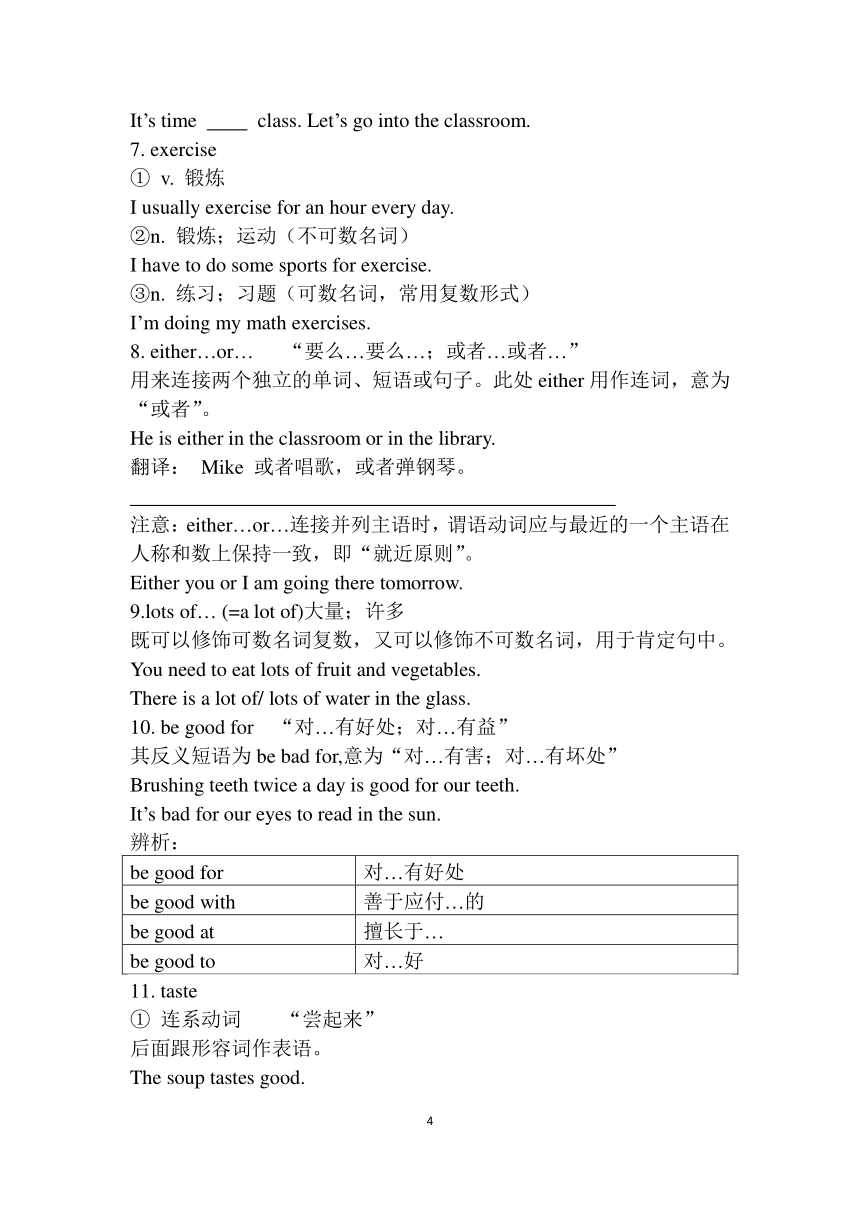人教英语七年级下册Unit 2 What time do you go to school?知识点
文档属性
| 名称 | 人教英语七年级下册Unit 2 What time do you go to school?知识点 |  | |
| 格式 | zip | ||
| 文件大小 | 86.0KB | ||
| 资源类型 | 教案 | ||
| 版本资源 | 人教新目标(Go for it)版 | ||
| 科目 | 英语 | ||
| 更新时间 | 2021-01-15 15:50:30 | ||
图片预览




文档简介
Unit
2
What
time
do
you
go
to
school?
知识点
一、课本基础知识梳理:
(一)单词词形转换:
1.up(adv.)
向上
→
down
(反义词)
2.dress(n.)
连衣裙
→
dresses
(复数)
3.brush(n.)
刷子
→
brushes
(复数)
4.usual(adj.)
通常的
→
usually
(adv.)
5.early
(adj.&adv.)
早的(地)
→
late
(反义词)
6.half(n.)
一半
→
halves
(复数)
7.run(v.)
跑
→
runner
(n.)→
running
(现在分词)→
ran
(过去式)
8.
quick(adj.)
快的
→
quickly
(adv.)
9.
life(n.)
生命
→
lives
(复数)
(二)短语和句型:
1.get
up起床;站起;起身
2.get
dressed穿上衣服
3.go
to
school去上学
4.brush
one’s
teeth刷牙
5.take
a
shower=have
a
shower洗淋浴
6.eat
breakfast
=have
breakfast
吃早餐
7.radio
station广播电台
8.from…to…
从……到……
9.at
night
在晚上
10.go
to
work
去上班
11.be
late
for迟到
12.on
school
days
在上学日
13.on
weekends
在周末
14.do
(one's)
homework
做作业
15.go
home回家
16.take
a
walk=have
a
walk=go
for
a
walk
散步;走一走
17.go
to
bed睡觉
18.clean
the
room打扫房间
19.eat
quickly吃得快
20.half
an
hour半小时
21.get
home到家
22.either…or…
要么……要么……,或者……或者……
23.lots
of=a
lot
of大量;许多
24.be
good
for对……有益
25.taste
good尝起来不错
26.
have
a/an
…life
过着…的生活
27.
need
to
do
sth.
需要做某事
28.
Here
+be+名词
这是…
二:重要知识点讲解:
1.get
dressed
穿上衣服
①辨析get
dressed
和be
dressed
in
get
dressed
穿上衣服
表示“穿”的动作,后不能接宾语
be
dressed
in
穿着
表示“穿”的状态,后接衣服或颜色
Please
get
up
and
get
dressed
quickly.
She
is
dressed
in
red.
②dress
动词:穿衣服;给(某人)穿衣服
宾语只能是表示人的名词或代词。
dress
sb./oneself
给某人/自己穿衣服
I
usually
dress
my
son
before
I
go
to
work.
Tom
can
dress
himself
now.
2.
usually
usually频度副词,意为“通常地”,常用于be动词、助动词或情态动词之后,行为动词之前。
We
usually
get
up
before
six
o'clock.
常见的频度副词:
always
总是;一直
usually
通常
often
经常;常常
sometimes
有时
hardly
几乎不
never
从不
★下面的排列更直观地说明了常见频度副词频率的"大小"。
always>usually>often>sometimes>hardly>never
3.
时间介词at
表示“在”,用来表示时间,其后一般跟表示钟点的词,如at
nine
o’clock。at还可以用在某些固定短语中,如at
night,
at
noon
拓展:时间介词on与in:
①on用在日期、星期几、节日等具体某天前,也用来表示在具体某天的上午、下午或晚上。
on
Monday
on
November
20th
on
Children’s
Day
on
Friday
morning
on
the
afternoon
of
May
8th
②in用在月份、季节、年份等前面,也可以表示在上午、下午或晚上。
in
March
in
2020
in
winter
in
the
morning
助记口诀:
时间介词on,
at与in的用法
on后具体某一天,日期、星期、节日前。
at用在时刻前,也与正午、午夜连。
月份、季节与年份,
in须用在其前面。
4.
辨析job与work
work
不可数名词
从事的体力或脑力劳动,即各类工作
job
可数名词
具体的职业或工作
He
has
a
lot
of
work
to
do
every
day.
Mary
has
a
good
job
in
a
bank.
5.
from…to…“从…到…”
用于表示时间、地点、数目等。
from
home
to
school
from
Monday
to
Friday
we
work
from
morning
to
night.
How
far
is
it
from
your
home
to
school?
6.
time
for
做…的时间
句型
It’s
time
for…
到做…的时间了
It’s
time
for
breakfast.
It’s
time
for
having
lunch.
拓展:
由time构成的常见句式:
①It’s
time
to
do
sth.
到做某事的时间了。
It’s
time
to
play
football.
②
It’s
time
for
sb.
to
do
sth.
到某人做某事的时间了。
It’s
time
for
us
to
go
to
bed.
Exercise:
It’s
time
class.
Let’s
go
into
the
classroom.
7.
exercise
①
v.
锻炼
I
usually
exercise
for
an
hour
every
day.
②n.
锻炼;运动(不可数名词)
I
have
to
do
some
sports
for
exercise.
③n.
练习;习题(可数名词,常用复数形式)
I’m
doing
my
math
exercises.
8.
either…or…
“要么…要么…;或者…或者…”
用来连接两个独立的单词、短语或句子。此处either用作连词,意为“或者”。
He
is
either
in
the
classroom
or
in
the
library.
翻译:
Mike
或者唱歌,或者弹钢琴。
注意:either…or…连接并列主语时,谓语动词应与最近的一个主语在人称和数上保持一致,即“就近原则”。
Either
you
or
I
am
going
there
tomorrow.
9.lots
of…
(=a
lot
of)大量;许多
既可以修饰可数名词复数,又可以修饰不可数名词,用于肯定句中。
You
need
to
eat
lots
of
fruit
and
vegetables.
There
is
a
lot
of/
lots
of
water
in
the
glass.
10.
be
good
for
“对…有好处;对…有益”
其反义短语为be
bad
for,意为“对…有害;对…有坏处”
Brushing
teeth
twice
a
day
is
good
for
our
teeth.
It’s
bad
for
our
eyes
to
read
in
the
sun.
辨析:
be
good
for
对…有好处
be
good
with
善于应付…的
be
good
at
擅长于…
be
good
to
对…好
11.
taste
①
连系动词
“尝起来”
后面跟形容词作表语。
The
soup
tastes
good.
类似的表示感觉的连系动词还有look(看起来)sound(听起来)smell(闻起来)feel(感觉起来)
②实义动词
“品尝;尝”
Can
you
taste
it?
③
名词
“味道”
This
orange
has
a
sweet
taste.
12.
Here
are
your
clothes.
here引起的倒装句
当副词here,
there
等位于句首且主语为名词时,句子要完全倒装。在一些英语句子中,谓语动词出现在主语之前,这种现象叫倒装。
Here
comes
the
bus!
Here
is
a
letter
for
you.
注:在副词here,
there
位于句首的句子中,若主语是人称代词,主谓不用倒装。
Here
it
is.
三:重要语法知识讲解
(一)英语时刻的表达法:顺读法和逆读法。
顺读法:钟点数+分钟数。
4:25→four
twenty-five,6:58→six
fifty-eitht,7:→seven
o′clock
说明:这种表达不论分钟数是多少,均可使用。
逆读法:分钟为+介词to/past+钟点数,可分两种情况:
1)分钟为不超过半小时,用分钟数+past(/pa:st/过)+钟点数。
4:23→twenty-three
past
four,5:19→nineteen
past
five.
2)分钟数超过了半小时,用(所差的)分钟的+to+(下一个)钟点。
7:31→twenty-nine
to
eight,10:58→two
to
eleven
温馨提示:
(1)特殊时间段的表示法:
30分钟可以使用half代替;15分钟可以使用quarter代替。如:
5:
30
half
past
five;
9:
45 a
quarter
to
ten。
(2)在某一时刻使用介词at
。
(3)提问时间使用:
“What
time
is
it?”
或“What's
the
time?”
(二)what
time/when
引导的特殊疑问句
1.
what
time
和when
都可以提问时间,意为“什么时候”
what
time
询问具体时刻
when
询问年份、月份、日期,也可以询问时刻
—What
time
is
it?
—It’s
eight
o’clock.
—When
is
your
birthday?
—My
birthday
is
on
May
10th.
What
time/
when
do
you
usually
go
to
school?
2.
句式结构及回答
1).
结构:
特殊疑问词+
be
+
主语?
特殊疑问词+
助动词do/does+
主语+
实义动词?
When/What
time
is
the
party?
When
do
you
go
to
school?
What
time
does
he
go
to
work?
2).回答时可以用in,
on,或at组成的表示时间的介词短语。
(三)频度副词
一).频率副词是表示与次数,频率有关的副词,如:
always(总是),
usually(通常),
often
(经常)sometimes(有时),
seldom(不常),
hardly10%(几乎不)
hardly
ever(几乎从不)
never(从不)等。
Always100%>usually85%>often75%>sometimes20%>seldom15%>never0%
二)频率副词在句子中的位置
①在be动词,情态动词及第一个助动词之后。
She
is
always
kind
to
us.
I
can
never
forget
the
day.
The
work
has
never
been
done.
②实义动词之前
He
often
goes
to
school
early.
③有时为了强调,可放在句首。
Sometime
I
stay
at
home
during
the
weekend.
三)
对这些频度副词提问时,用how
often。如:
Sometimes
I
write
to
my
brother.
How
often
do
you
write
to
your
brother?
习题
选择填空。
1.
After
_______
lunch
he
plays
_______
guitar.
?A.
the?,
the???????????????
B.
/,
/????????????
C.
/
,
the?
D.
the?,
/
2.
I
want
to
know
something
_______
your
evening.
?A.
about????????????????
B.
on???????????????????
C.
around
D.
in
3.
He
_________
at
6:00
in
the
afternoon.
?A.
get
home????????
B.
gets
to
home???????
C.
gets
home
D.
go
to
home
4.
_______
at
8:00
in
the
morning.
?A.
The
classes
begins??
?
B.
Class
begin???????
C.
Class
begins
D.
Begin
class
5.
He
_________
his
homework
________
Sunday
morning.
?A.
doesn’t,
on?????
B.
don’t
do,
in???
C.
don’t,
in
D.
doesn’t
do,
on
6.
---What’s
the
time
?
---_______9:40.
A.
It
B.
It’s
C.
This
D.
This
is
7.
Hurry
up!
It’s
time
________
school.
??A.
go
to??????????????
B.
for??????????????
C.
to
go
D.
to
going
8.
Mike
likes
______
TV
and
Jim
likes
______
books.
A.
to
watch;
to
read
???
??B.
to
watch;
to
see???????
C.
to
see
;
to
read
D.
to
see;
to
look
9.Now
please
look
________
the
picture
and
listen
________
me.
A.
at;
at
B.
at;
to
C.
to;
at
D.
to;
to
10.
.It’s
________
now.
A.
nine
and
forty-four
B.
nine-forty-four
C.
nine
forty-four
D.
nine
and
forty
four
11.----
do
you
usually
get
up?
----
At
six
o’clock.
A.
What
B.
What
time
C.
Why
D.
How
12.Jim
housework
on
weekdays.
He
it
on
weekends.
A.
doesn’t
do;
does
B.
doesn’t
;does
C.
isn’t
do;
does
D.
doesn’t
;do
13.----Tell
us
something
about
Canada,
OK?
----
I’m
sorry.
Jack
I
have
ever
been
there.
A.
Either;
or
B.
Not
only;
but
also
C.
Both;
and
D.
Neither;
nor
14.It’s
a
good
to
have
breakfast
every
morning.
A.
hobby
B.
job
C.
menu
D.
habit
15.----
It’s
said
that
this
kind
of
tofu
smells
terrible.
----
That’s
true
.
But
it
delicious.
A.
feels
B.
sounds
C.
tastes
16.I
often
have
egg
and
a
glass
of
mild
for
breakfast
every
day
.
A.
an;
/
B.a;
/
C.an;
the
D.a;
the
17.What
number
bus
do
you
?
A.
have
B.get
C.take
D.go
18.Tony
often
goes
to
bed
nine
o’clock.
A.
in
B.on
C.at
D.for
19.He
his
homework
Sundays.
A.
doesn’t;
on
B.
don’t
do
;
in
C.
doesn’t
do;
on
D.
don’t
;
on
20.Tom
usually
goes
to
school
7:30
the
morning.
A.
at
;
in
B.
in;
at
C.
on;
in
D.
at;
on
根据表格提示,以Mary’s
day为题,写一篇60-80词的短文,写出她一天的活动安排。要求语句通顺,行文流畅
起床
6:00
午饭
12:00
早饭
6:30
做作业
7:15
上学
7:30
看电视
9:00
上课
8:00
上床睡觉
10:00
1
2
What
time
do
you
go
to
school?
知识点
一、课本基础知识梳理:
(一)单词词形转换:
1.up(adv.)
向上
→
down
(反义词)
2.dress(n.)
连衣裙
→
dresses
(复数)
3.brush(n.)
刷子
→
brushes
(复数)
4.usual(adj.)
通常的
→
usually
(adv.)
5.early
(adj.&adv.)
早的(地)
→
late
(反义词)
6.half(n.)
一半
→
halves
(复数)
7.run(v.)
跑
→
runner
(n.)→
running
(现在分词)→
ran
(过去式)
8.
quick(adj.)
快的
→
quickly
(adv.)
9.
life(n.)
生命
→
lives
(复数)
(二)短语和句型:
1.get
up起床;站起;起身
2.get
dressed穿上衣服
3.go
to
school去上学
4.brush
one’s
teeth刷牙
5.take
a
shower=have
a
shower洗淋浴
6.eat
breakfast
=have
breakfast
吃早餐
7.radio
station广播电台
8.from…to…
从……到……
9.at
night
在晚上
10.go
to
work
去上班
11.be
late
for迟到
12.on
school
days
在上学日
13.on
weekends
在周末
14.do
(one's)
homework
做作业
15.go
home回家
16.take
a
walk=have
a
walk=go
for
a
walk
散步;走一走
17.go
to
bed睡觉
18.clean
the
room打扫房间
19.eat
quickly吃得快
20.half
an
hour半小时
21.get
home到家
22.either…or…
要么……要么……,或者……或者……
23.lots
of=a
lot
of大量;许多
24.be
good
for对……有益
25.taste
good尝起来不错
26.
have
a/an
…life
过着…的生活
27.
need
to
do
sth.
需要做某事
28.
Here
+be+名词
这是…
二:重要知识点讲解:
1.get
dressed
穿上衣服
①辨析get
dressed
和be
dressed
in
get
dressed
穿上衣服
表示“穿”的动作,后不能接宾语
be
dressed
in
穿着
表示“穿”的状态,后接衣服或颜色
Please
get
up
and
get
dressed
quickly.
She
is
dressed
in
red.
②dress
动词:穿衣服;给(某人)穿衣服
宾语只能是表示人的名词或代词。
dress
sb./oneself
给某人/自己穿衣服
I
usually
dress
my
son
before
I
go
to
work.
Tom
can
dress
himself
now.
2.
usually
usually频度副词,意为“通常地”,常用于be动词、助动词或情态动词之后,行为动词之前。
We
usually
get
up
before
six
o'clock.
常见的频度副词:
always
总是;一直
usually
通常
often
经常;常常
sometimes
有时
hardly
几乎不
never
从不
★下面的排列更直观地说明了常见频度副词频率的"大小"。
always>usually>often>sometimes>hardly>never
3.
时间介词at
表示“在”,用来表示时间,其后一般跟表示钟点的词,如at
nine
o’clock。at还可以用在某些固定短语中,如at
night,
at
noon
拓展:时间介词on与in:
①on用在日期、星期几、节日等具体某天前,也用来表示在具体某天的上午、下午或晚上。
on
Monday
on
November
20th
on
Children’s
Day
on
Friday
morning
on
the
afternoon
of
May
8th
②in用在月份、季节、年份等前面,也可以表示在上午、下午或晚上。
in
March
in
2020
in
winter
in
the
morning
助记口诀:
时间介词on,
at与in的用法
on后具体某一天,日期、星期、节日前。
at用在时刻前,也与正午、午夜连。
月份、季节与年份,
in须用在其前面。
4.
辨析job与work
work
不可数名词
从事的体力或脑力劳动,即各类工作
job
可数名词
具体的职业或工作
He
has
a
lot
of
work
to
do
every
day.
Mary
has
a
good
job
in
a
bank.
5.
from…to…“从…到…”
用于表示时间、地点、数目等。
from
home
to
school
from
Monday
to
Friday
we
work
from
morning
to
night.
How
far
is
it
from
your
home
to
school?
6.
time
for
做…的时间
句型
It’s
time
for…
到做…的时间了
It’s
time
for
breakfast.
It’s
time
for
having
lunch.
拓展:
由time构成的常见句式:
①It’s
time
to
do
sth.
到做某事的时间了。
It’s
time
to
play
football.
②
It’s
time
for
sb.
to
do
sth.
到某人做某事的时间了。
It’s
time
for
us
to
go
to
bed.
Exercise:
It’s
time
class.
Let’s
go
into
the
classroom.
7.
exercise
①
v.
锻炼
I
usually
exercise
for
an
hour
every
day.
②n.
锻炼;运动(不可数名词)
I
have
to
do
some
sports
for
exercise.
③n.
练习;习题(可数名词,常用复数形式)
I’m
doing
my
math
exercises.
8.
either…or…
“要么…要么…;或者…或者…”
用来连接两个独立的单词、短语或句子。此处either用作连词,意为“或者”。
He
is
either
in
the
classroom
or
in
the
library.
翻译:
Mike
或者唱歌,或者弹钢琴。
注意:either…or…连接并列主语时,谓语动词应与最近的一个主语在人称和数上保持一致,即“就近原则”。
Either
you
or
I
am
going
there
tomorrow.
9.lots
of…
(=a
lot
of)大量;许多
既可以修饰可数名词复数,又可以修饰不可数名词,用于肯定句中。
You
need
to
eat
lots
of
fruit
and
vegetables.
There
is
a
lot
of/
lots
of
water
in
the
glass.
10.
be
good
for
“对…有好处;对…有益”
其反义短语为be
bad
for,意为“对…有害;对…有坏处”
Brushing
teeth
twice
a
day
is
good
for
our
teeth.
It’s
bad
for
our
eyes
to
read
in
the
sun.
辨析:
be
good
for
对…有好处
be
good
with
善于应付…的
be
good
at
擅长于…
be
good
to
对…好
11.
taste
①
连系动词
“尝起来”
后面跟形容词作表语。
The
soup
tastes
good.
类似的表示感觉的连系动词还有look(看起来)sound(听起来)smell(闻起来)feel(感觉起来)
②实义动词
“品尝;尝”
Can
you
taste
it?
③
名词
“味道”
This
orange
has
a
sweet
taste.
12.
Here
are
your
clothes.
here引起的倒装句
当副词here,
there
等位于句首且主语为名词时,句子要完全倒装。在一些英语句子中,谓语动词出现在主语之前,这种现象叫倒装。
Here
comes
the
bus!
Here
is
a
letter
for
you.
注:在副词here,
there
位于句首的句子中,若主语是人称代词,主谓不用倒装。
Here
it
is.
三:重要语法知识讲解
(一)英语时刻的表达法:顺读法和逆读法。
顺读法:钟点数+分钟数。
4:25→four
twenty-five,6:58→six
fifty-eitht,7:→seven
o′clock
说明:这种表达不论分钟数是多少,均可使用。
逆读法:分钟为+介词to/past+钟点数,可分两种情况:
1)分钟为不超过半小时,用分钟数+past(/pa:st/过)+钟点数。
4:23→twenty-three
past
four,5:19→nineteen
past
five.
2)分钟数超过了半小时,用(所差的)分钟的+to+(下一个)钟点。
7:31→twenty-nine
to
eight,10:58→two
to
eleven
温馨提示:
(1)特殊时间段的表示法:
30分钟可以使用half代替;15分钟可以使用quarter代替。如:
5:
30
half
past
five;
9:
45 a
quarter
to
ten。
(2)在某一时刻使用介词at
。
(3)提问时间使用:
“What
time
is
it?”
或“What's
the
time?”
(二)what
time/when
引导的特殊疑问句
1.
what
time
和when
都可以提问时间,意为“什么时候”
what
time
询问具体时刻
when
询问年份、月份、日期,也可以询问时刻
—What
time
is
it?
—It’s
eight
o’clock.
—When
is
your
birthday?
—My
birthday
is
on
May
10th.
What
time/
when
do
you
usually
go
to
school?
2.
句式结构及回答
1).
结构:
特殊疑问词+
be
+
主语?
特殊疑问词+
助动词do/does+
主语+
实义动词?
When/What
time
is
the
party?
When
do
you
go
to
school?
What
time
does
he
go
to
work?
2).回答时可以用in,
on,或at组成的表示时间的介词短语。
(三)频度副词
一).频率副词是表示与次数,频率有关的副词,如:
always(总是),
usually(通常),
often
(经常)sometimes(有时),
seldom(不常),
hardly10%(几乎不)
hardly
ever(几乎从不)
never(从不)等。
Always100%>usually85%>often75%>sometimes20%>seldom15%>never0%
二)频率副词在句子中的位置
①在be动词,情态动词及第一个助动词之后。
She
is
always
kind
to
us.
I
can
never
forget
the
day.
The
work
has
never
been
done.
②实义动词之前
He
often
goes
to
school
early.
③有时为了强调,可放在句首。
Sometime
I
stay
at
home
during
the
weekend.
三)
对这些频度副词提问时,用how
often。如:
Sometimes
I
write
to
my
brother.
How
often
do
you
write
to
your
brother?
习题
选择填空。
1.
After
_______
lunch
he
plays
_______
guitar.
?A.
the?,
the???????????????
B.
/,
/????????????
C.
/
,
the?
D.
the?,
/
2.
I
want
to
know
something
_______
your
evening.
?A.
about????????????????
B.
on???????????????????
C.
around
D.
in
3.
He
_________
at
6:00
in
the
afternoon.
?A.
get
home????????
B.
gets
to
home???????
C.
gets
home
D.
go
to
home
4.
_______
at
8:00
in
the
morning.
?A.
The
classes
begins??
?
B.
Class
begin???????
C.
Class
begins
D.
Begin
class
5.
He
_________
his
homework
________
Sunday
morning.
?A.
doesn’t,
on?????
B.
don’t
do,
in???
C.
don’t,
in
D.
doesn’t
do,
on
6.
---What’s
the
time
?
---_______9:40.
A.
It
B.
It’s
C.
This
D.
This
is
7.
Hurry
up!
It’s
time
________
school.
??A.
go
to??????????????
B.
for??????????????
C.
to
go
D.
to
going
8.
Mike
likes
______
TV
and
Jim
likes
______
books.
A.
to
watch;
to
read
???
??B.
to
watch;
to
see???????
C.
to
see
;
to
read
D.
to
see;
to
look
9.Now
please
look
________
the
picture
and
listen
________
me.
A.
at;
at
B.
at;
to
C.
to;
at
D.
to;
to
10.
.It’s
________
now.
A.
nine
and
forty-four
B.
nine-forty-four
C.
nine
forty-four
D.
nine
and
forty
four
11.----
do
you
usually
get
up?
----
At
six
o’clock.
A.
What
B.
What
time
C.
Why
D.
How
12.Jim
housework
on
weekdays.
He
it
on
weekends.
A.
doesn’t
do;
does
B.
doesn’t
;does
C.
isn’t
do;
does
D.
doesn’t
;do
13.----Tell
us
something
about
Canada,
OK?
----
I’m
sorry.
Jack
I
have
ever
been
there.
A.
Either;
or
B.
Not
only;
but
also
C.
Both;
and
D.
Neither;
nor
14.It’s
a
good
to
have
breakfast
every
morning.
A.
hobby
B.
job
C.
menu
D.
habit
15.----
It’s
said
that
this
kind
of
tofu
smells
terrible.
----
That’s
true
.
But
it
delicious.
A.
feels
B.
sounds
C.
tastes
16.I
often
have
egg
and
a
glass
of
mild
for
breakfast
every
day
.
A.
an;
/
B.a;
/
C.an;
the
D.a;
the
17.What
number
bus
do
you
?
A.
have
B.get
C.take
D.go
18.Tony
often
goes
to
bed
nine
o’clock.
A.
in
B.on
C.at
D.for
19.He
his
homework
Sundays.
A.
doesn’t;
on
B.
don’t
do
;
in
C.
doesn’t
do;
on
D.
don’t
;
on
20.Tom
usually
goes
to
school
7:30
the
morning.
A.
at
;
in
B.
in;
at
C.
on;
in
D.
at;
on
根据表格提示,以Mary’s
day为题,写一篇60-80词的短文,写出她一天的活动安排。要求语句通顺,行文流畅
起床
6:00
午饭
12:00
早饭
6:30
做作业
7:15
上学
7:30
看电视
9:00
上课
8:00
上床睡觉
10:00
1
同课章节目录
- Unit 1 Can you play the guitar?
- Section A
- Section B
- Unit 2 What time do you go to school?
- Section A
- Section B
- Unit 3 How do you get to school?
- Section A
- Section B
- Unit 4 Don't eat in class.
- Section A
- Section B
- Unit 5 Why do you like pandas?
- Section A
- Section B
- Unit 6 I'm watching TV.
- Section A
- Section B
- Review of Units 1-6
- Unit 7 It's raining!
- Section A
- Section B
- Unit 8 Is there a post office near here?
- Section A
- Section B
- Unit 9 What does he look like?
- Section A
- Section B
- Unit 10 I'd like some noodles.
- Section A
- Section B
- Unit 11 How was your school trip?
- Section A
- Section B
- Unit 12 What did you do last weekend?
- Section A
- Section B
